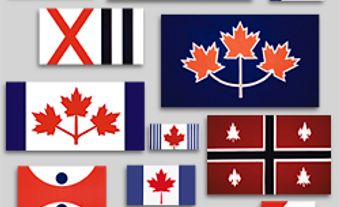While in search of a passage to Asia, the explorer John Cabot (Giovanni Caboto) landed on the shore of North America on 24 June 1497, and claimed it for King Henry VII of England. He brought a crucifix ashore and raised the Royal Banner. The latter consisted of a square device — the four quarters of the Tudor coat of arms — depicting, twice, three gold lions on a red field and three gold fleurs-de-lys (lilies) on a blue field.

Although it doesn’t appear that Jacques Cartier planted a flag at Gaspé on 24 July 1534, he claimed the land for France and raised a cross that bore a shield with three fleurs-de-lys, to represent the King of France. As New France developed, a variety of flags flew over settlements and permanent communities in what became Canada. They included the royal flag of France (formally, the Banner of France) — the three golden fleurs-de-lys on a blue field — as well as plain white naval ensigns, white flags with fleurs-de-lys and a number of regimental flags.
For the next two centuries, both Great Britain and France flew their banners over different parts of what is now Canada to signify royal sovereignty over those lands.
The Development of the Royal Union Flag
John Cabot could have unfurled the Cross of St. George — consisting of a red cross on a white field — in 1497 when he claimed North America for the English Crown. The cross of England’s patron saint had developed as a national symbol of England from 1277 onward and was borne on armour, clothing and small flags.

The Cross of St. George was succeeded by the first version of the Royal Union Flag, created in 1606 through the combination of the red Cross of St. George with the white saltire Cross of St. Andrew (the patron saint of Scotland) on a blue field. This flag was the result of the kingdoms of England and Scotland uniting under King James I/VI (England/Scotland). In 1707, England and Scotland were formally joined as the United Kingdom of Great Britain under Queen Anne.

This version of the union flag was probably introduced in Canada not long after, most likely in Newfoundland, but also, over time, by ships of the Royal Navy, units of the British army, and vessels and forts of the Hudson’s Bay Company. (When unfurled at sea, the Royal Union Flag was, and remains, referred to as the Union Jack.)

In 1801, the second — and current — version of the Union Flag was created under King George III with the union of Great Britain and Ireland, adding the red saltire Cross of St. Patrick, the patron saint of Ireland, to the overall design, which remains in effect to this day.
Usage in Canada Before 1965
In 1763, following the defeat of the French in the North American portion of the Seven Years’ War, the Canadian colonies were transferred from France to Great Britain. As such, the Royal Union Flag became the banner that identified the British North American lands that would later be part of Canada (Newfoundland, Nova Scotia, New Brunswick, Prince Edward Island, Ontario, Québec and the islands of the Gulf of St. Lawrence) as colonies of the British Crown.
Although a step towards independence, Confederation did not result in the formal adoption of a new national flag. As part of the British Empire, Canada continued to use the 1801 version of the Royal Union Flag as its representative flag.
For nearly a century, the Royal Union Flag vied with the Canadian Red Ensign (the Red Ensign with the Coat of Arms of Canada in the fly) as the representative banner for the nation. For example, originally the Canadian Red Ensign flew atop the centre tower of the Parliament Buildings in Ottawa. However, by the early 20th century, the Royal Union Flag took its place during a period of imperial ascendancy, brought on, in part, by the 60th anniversary of Queen Victoria’s reign and by the South African War.
Nonetheless, during the 20th century, the Royal Union Flag lost ground to the Canadian Red Ensign, with the latter gaining increased official status within the federal government and the military, particularly when it involved differentiating Canadian institutions located alongside their British counterparts that naturally flew the Royal Union Flag.
Usage in Canada Since 1965
With the adoption of the maple leaf–based National Flag of Canada in 1965, the role of the Royal Union Flag changed within Canada. On 18 December 1964, Parliament resolved that the Royal Union Flag would continue to serve as a symbol of the nation’s allegiance to the Crown and of the country’s membership in the Commonwealth. As a result, the Royal Union Flag can still be flown in Canada (alongside the national flag) at federal government buildings, on military bases, and at airports on particular days, including the Queen’s birthday, the anniversary of the Statute of Westminster (11 December), on Commonwealth Day (the second Monday in March), during Royal visits and visits from officials of the United Kingdom.
In addition, the Union Jack continues to fly within Canada as part of the designs of the provincial flags of British Columbia, Manitoba, Ontario, and Newfoundland and Labrador.

 Share on Facebook
Share on Facebook Share on X
Share on X Share by Email
Share by Email Share on Google Classroom
Share on Google Classroom


